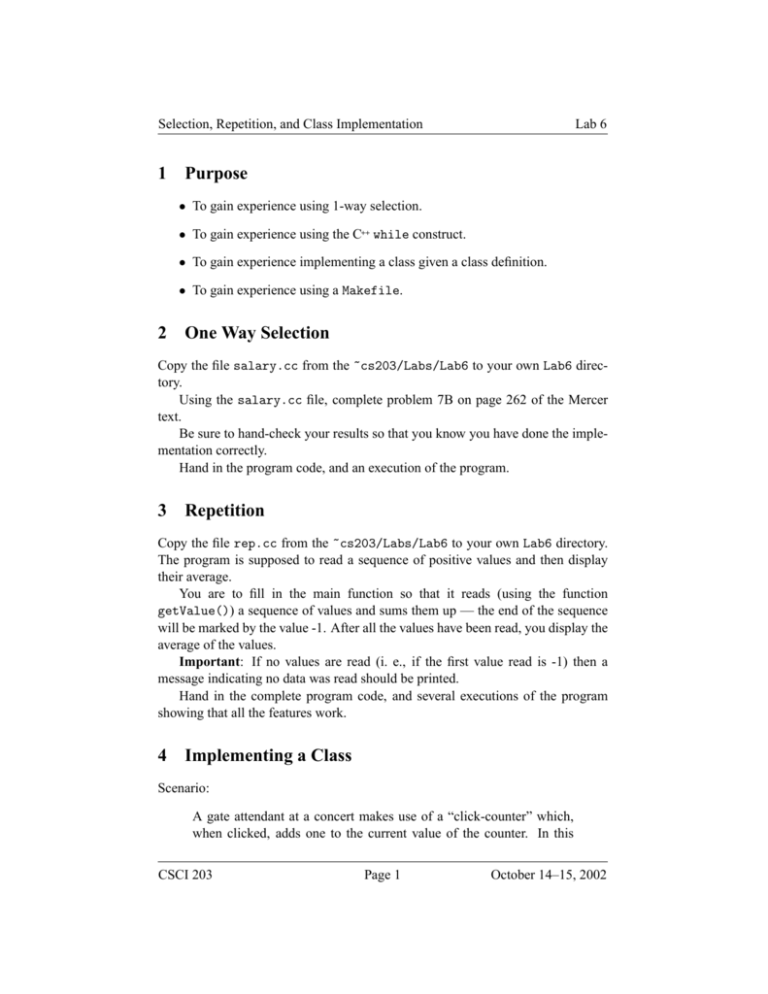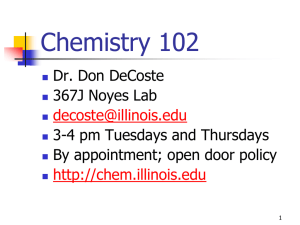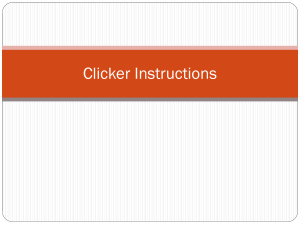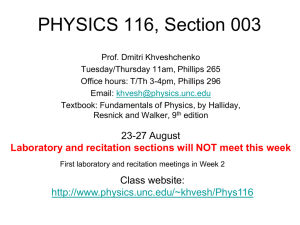1 Purpose 2 One Way Selection 3 Repetition 4 Implementing a Class
advertisement

Selection, Repetition, and Class Implementation
1
Lab 6
Purpose
• To gain experience using 1-way selection.
• To gain experience using the C++ while construct.
• To gain experience implementing a class given a class definition.
• To gain experience using a Makefile.
2
One Way Selection
Copy the file salary.cc from the ~cs203/Labs/Lab6 to your own Lab6 directory.
Using the salary.cc file, complete problem 7B on page 262 of the Mercer
text.
Be sure to hand-check your results so that you know you have done the implementation correctly.
Hand in the program code, and an execution of the program.
3
Repetition
Copy the file rep.cc from the ~cs203/Labs/Lab6 to your own Lab6 directory.
The program is supposed to read a sequence of positive values and then display
their average.
You are to fill in the main function so that it reads (using the function
getValue()) a sequence of values and sums them up — the end of the sequence
will be marked by the value -1. After all the values have been read, you display the
average of the values.
Important: If no values are read (i. e., if the first value read is -1) then a
message indicating no data was read should be printed.
Hand in the complete program code, and several executions of the program
showing that all the features work.
4
Implementing a Class
Scenario:
A gate attendant at a concert makes use of a “click-counter” which,
when clicked, adds one to the current value of the counter. In this
CSCI 203
Page 1
October 14–15, 2002
Selection, Repetition, and Class Implementation
Lab 6
way, when everyone has entered the concert, the number of people
admitted can be determined.
The click-counter has two buttons: the counter button, which when
pressed increments the counter, and the reset button which sets the
counter value to zero. The click-counter also has a window containing
a sequence (probably 4) rotating wheels with the digits from 0 through
9. These rotate appropriately to represent the number counted so far.
The important thing about the window is that it sets a maximum on
the number of things which can be counted — it will automatically
roll back to 0 when the maximum number is incremented.
We want to develop a similar kind of counting device which can be used in a
program to, for example, count the number of times an object is accessed or the
number of times a loop repeats.
Here is a class definition for a software click-counter.
#ifndef CLICKER_H
#define CLICKER_H
class Clicker {
public:
Clicker();
Clicker(int inMaxCount);
void click();
void reset();
void setMaxCount(int inMaxCount);
void display() const;
int getCount() const;
int getMaxCount() const;
private:
int mCount;
int mMaxCount;
};
#endif
Carry out the following activities.
• Copy the files Clicker.h, testClicker.cc and Makefile from ~cs203/
Labs/Lab6 to your Lab6 directory.
CSCI 203
Page 2
October 14–15, 2002
Selection, Repetition, and Class Implementation
Lab 6
• Edit Clicker.h and add appropriate pre and postconditions for each
method.
• Create a new file Clicker.cc and write the implementations for each of the
methods (and constructors) of the class definition.
For the default constructor you can choose a value which will always be used
for the maximum (unless it is fixed in some other way).
For the display() method, print the current value of the counter and the
maximum count.
• Notice that the const after the three methods is a promise that the function
doesn’t change the state of the object.
• Notice in the file Clicker.h that the first two and last lines are compiler
directives (since they begin with #) and they make sure that if you happen
to include Clicker.h twice by mistake, the second inclusion will have no
effect. Without these lines you would end up with lots of “doubly defined”
object and abstraction names.
The notion #ifndef CLICKER_H is read “if CLICKER_H is not defined then
continue, otherwise skip to the #endif. Notice that if CLICKER_H is defined, then the lines after the #ifndef will not be seen by the compiler. The
#define CLICKER_H line obviously defines the name CLICKER_H and then
goes on. That will only be done the first time the file is included!
• Examine testClicker.cc to see how it works. It has no other purpose than
to act as a testing ground for the Clicker class.
Move to your Lab6 directory. Now, compile your program by typing make
after the Unix prompt. The command make performs the instructions in the
Makefile you copied. We will learn how to create our own Makefile files
later.
After compiling, run the executable to test the class definition. Modify the
program to test the following feature of the class. You should show that the
clicker object actually rolls back to 0 properly when the maximum value is
reached. (How do you suppose you should initialize the maximum count to
test this? 10000? 100? Something else?)
Turn in all the code for this part: Clicker.h, Clicker.cc, and your final
version of testClicker.cc along with the execution of testClicker.cc.
When you are finished, be sure to clean up your directory. Type make clean
at the Unix prompt. This will remove all of your .o files and your .exe file. You
should clean up your files after each lab.
CSCI 203
Page 3
October 14–15, 2002







